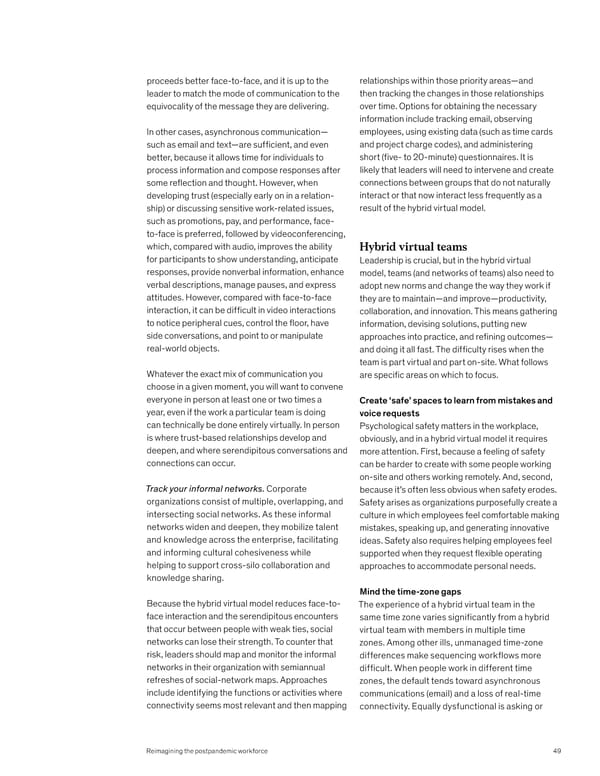proceeds better face-to-face, and it is up to the relationships within those priority areas—and leader to match the mode of communication to the then tracking the changes in those relationships equivocality of the message they are delivering. over time. Options for obtaining the necessary information include tracking email, observing In other cases, asynchronous communication— employees, using existing data (such as time cards such as email and text—are sufficient, and even and project charge codes), and administering better, because it allows time for individuals to short (five- to 20-minute) questionnaires. It is process information and compose responses after likely that leaders will need to intervene and create some reflection and thought. However, when connections between groups that do not naturally developing trust (especially early on in a relation- interact or that now interact less frequently as a ship) or discussing sensitive work-related issues, result of the hybrid virtual model. such as promotions, pay, and performance, face- to-face is preferred, followed by videoconferencing, which, compared with audio, improves the ability Hybrid virtual teams for participants to show understanding, anticipate Leadership is crucial, but in the hybrid virtual responses, provide nonverbal information, enhance model, teams (and networks of teams) also need to verbal descriptions, manage pauses, and express adopt new norms and change the way they work if attitudes. However, compared with face-to-face they are to maintain—and improve—productivity, interaction, it can be difficult in video interactions collaboration, and innovation. This means gathering to notice peripheral cues, control the floor, have information, devising solutions, putting new side conversations, and point to or manipulate approaches into practice, and refining outcomes— real-world objects. and doing it all fast. The difficulty rises when the team is part virtual and part on-site. What follows Whatever the exact mix of communication you are specific areas on which to focus. choose in a given moment, you will want to convene everyone in person at least one or two times a Create ‘safe’ spaces to learn from mistakes and year, even if the work a particular team is doing voice requests can technically be done entirely virtually. In person Psychological safety matters in the workplace, is where trust-based relationships develop and obviously, and in a hybrid virtual model it requires deepen, and where serendipitous conversations and more attention. First, because a feeling of safety connections can occur. can be harder to create with some people working on-site and others working remotely. And, second, Track your informal networks. Corporate because it’s often less obvious when safety erodes. organizations consist of multiple, overlapping, and Safety arises as organizations purposefully create a intersecting social networks. As these informal culture in which employees feel comfortable making networks widen and deepen, they mobilize talent mistakes, speaking up, and generating innovative and knowledge across the enterprise, facilitating ideas. Safety also requires helping employees feel and informing cultural cohesiveness while supported when they request flexible operating helping to support cross-silo collaboration and approaches to accommodate personal needs. knowledge sharing. Mind the time-zone gaps Because the hybrid virtual model reduces face-to- The experience of a hybrid virtual team in the face interaction and the serendipitous encounters same time zone varies significantly from a hybrid that occur between people with weak ties, social virtual team with members in multiple time networks can lose their strength. To counter that zones. Among other ills, unmanaged time-zone risk, leaders should map and monitor the informal differences make sequencing workflows more networks in their organization with semiannual difficult. When people work in different time refreshes of social-network maps. Approaches zones, the default tends toward asynchronous include identifying the functions or activities where communications (email) and a loss of real-time connectivity seems most relevant and then mapping connectivity. Equally dysfunctional is asking or Reimagining the postpandemic workforce 49
 What Now? Page 50 Page 52
What Now? Page 50 Page 52